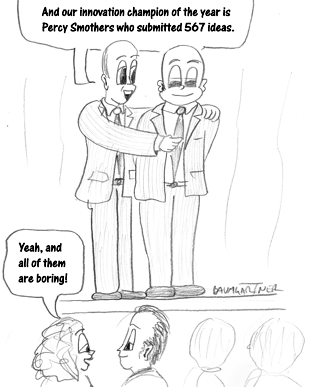
Collecting Ideas Is Killing Your Innovation
By Jeffrey Baumgartner
Having spoken to many innovation managers over the years, I have observed two things. Firstly, most of them oversee initiatives designed to capture lots of ideas and, secondly, the collection of those ideas is destroying their innovation initiatives, stifling creativity and holding back actual innovation. Fortunately, there is a simple solution. But, first, let us look at the reasons why business has become so obsessive about collecting ideas and why this is bad for innovation.
Quantity over Quality
Although it is now widely discredited, traditional brainstorming has for many years been the model for business creativity. The fundamental concept of brainstorming is that you must aim for quantity of ideas over quality of ideas because if you capture enough ideas, some of them will somehow have to be creative ideas -- although why this should be so is not clear. Nevertheless, it is easy to see why this approach appeals to businesses and institutions. To be creative, according to this logic, you do not need to demonstrate creativity; you merely need to have lots of conventional ideas.
The notion that quantity magically leads to quality in creativity has become the basis for suggestion schemes, idea management tools, ideas campaigns and other tools that focus on capturing large numbers of ideas from the workforce and even the general public. Indeed, the measure of success of such systems is inevitably the number of ideas captured, rather than quality of ideas, value of ideas or even relevance of ideas. As a result, innovation managers have access to far more ideas than they know what to do with. That's bad for innovation. Really bad.
Why Bother with Creativity?
When your business focuses on capturing lots of ideas and rewarding every idea as a good idea -- so as not to hurt the feelings of the idea owner -- you are communicating to employees that they do no need to be creative: any idea is good enough. And since most business environments are not particularly conducive to creativity, and since most employees are reluctant to risk sharing outlandish ideas, they do not. They share safe, boring, conventional ideas secure in the knowledge that these ideas will be rewarded as much as, if not more so than, crazy ideas.
In other words, when you motivate people to have as many conventional ideas as possible, you do not motivate them to develop and risk sharing truly creative ideas. Rather you motivate them to share boring ideas. To look at it another way, imagine you launch a creative cake making competition in which entrants are rewarded for the number of cakes they submit rather than the creativity of the cakes submitted (so as not to discourage bakers). Do you think anyone would invest the time and effort to experiment with a truly creative cake recipe when it will not be rewarded any more than an ordinary and even badly cooked cake? Not likely!
Stagnation
If you have ever run or participated in a suggestion scheme initiative, such as one using idea management software, you will have probably found that the tool is initially good at capturing lots of ideas. But, few of those ideas come to fruition. As a result, many ideas sit in a database waiting in vain for some action to be taken with them.
The people who submit those ideas wait for notification that something is happening with their ideas. But, when they hear no news, they lose interest not only in their ideas, but in participating in a scheme that seems pointless. Why waste time -- something today's employees do not have enough of -- to develop and share an idea if nothing is going to happen to it?
As a result, participation rates in suggestion schemes inevitably decline over time -- unless a process is developed in which ideas are processed and progress is communicated to idea owners.
Mediocre Choices
Research and experience have shown that when a typical manager is faced with a list of ideas and asked to choose an idea to develop further, she will most likely choose a moderately creative idea over a highly creative idea. So, even if a brainstorm or a suggestion scheme actually evokes a very creative idea, it is unlikely to be selected by a decision maker. This is not because the manager consciously does not want creative ideas. Rather, when reviewing ideas, she is thinking about what steps would be needed to develop and implement an idea. A less creative idea not only demands less effort to implement, but it is less risky, making it more attractive to the busy manager than a risky creative idea that will demand a lot of effort, whose value may not be clear and which might fail anyway.
On the other hand, presenting to the manager a single, well developed creative vision leaves her with only one choice: whether to authorise the implementation of the vision or not.
Solution: Stop!
The solution to the problem involves five steps
-
Stop initiatives that capture lots of boring ideas. Increasing your stockpile of ignored ideas is no going to help at all. So, close those initiatives down as soon as you can.
-
Replace quantity based creativity initiatives with actions that focus on actually being creative such as Anticonventional thinking; crazy idea competitions, where ideas are rewarded for being outlandish rather than plentiful; and entrepreneurial competitions where teams develop innovative business plans. Encourage people to work on developing big creative visions rather than submitting lots of little, undeveloped ideas.
-
Develop mechanisms that enable people with crazy, creative visions (rather than boring ideas) to submit their visions to receptive decision makers.
-
Process the boring ideas remaining in databases as quickly and ruthlessly as possible. Reject ideas that are a waste of time and assign viable ideas to idea owners for implementation.
-
Replace ideation initiatives that capture ideas with a continuous improvement process in which people with little ideas can easily implement their ideas and be rewarded for the action of implementation rather than for the idea itself. This will lead to people thinking through their ideas as things to implement rather than words to submit to a suggestion scheme for creativity points. It will also separate small improvement ideas from your innovation initiative.
Once you get rid of the overabundance of boring ideas and focus on generating and developing truly creative visions, you can expect your innovation initiative to start demonstrating innovative results: the implementation of creative ideas that generate value either through increased revenues, reduced operational costs or both.
Is that not a far better goal than having lots of ideas?
Recent Articles
Leading Diverse Teams
Filed under: Business Innovation
Diverse teams are more innovative and smarter than homogeneous ones. But, they are also harder to manager. Here are some tips. By Jeffrey Baumgartner -- Read the article...
Questions you should ask when an innovative project fails
Filed under: Business Innovation
You can learn a lot from the failure of an innovative project, but you need to ask the right questions. Here are those questions. By Jeffrey Baumgartner -- Read the article...
Unmarketing the Competition
Filed under: Business Innovation
A look at creative, but unethical dirty trick marketing campaigns designed to damage the competition By Jeffrey Baumgartner -- Read the article...
Imaginativefulness and the Fisherman
Filed under: Creativity
What does a fisherman wearing a cycling helmet have to do with imaginativefulness? Quite a lot, it seems. By Jeffrey Baumgartner -- Read the article...
Actually, Criticising Ideas Is Good for Creativity
Filed under: Creativity
People have long assumed criticising ideas in a brainstorm inhibits creativity. Research and experience shows that is wrong By Jeffrey Baumgartner -- Read the article...
Imaginativefulness
Filed under: Creativity
Imaginativefulness is a state of heightened imagination in which your mind allows thoughts, memories and ideas to play with each other freely. By Jeffrey Baumgartner -- Read the article...
Why and How to Exploit Alternative Uses for Your Products
Filed under: Business Innovation
Discovering new ways customers use, misuse and could use your products can inspire innovation. Jeffrey Baumgartner explains. By Jeffrey Baumgartner -- Read the article...
The Cost of Not Innovating
Filed under: Business Innovation
If your company fails to innovate, you pay a steep price in terms of loss of leadershop, tight margins, missed opportunities and more. By Jeffrey Baumgartner -- Read the article...
Don't Trust the Status Quo
Filed under: Creativity
Jeffrey Baumgartner has never trusted the status quo. He explains why this is so and why you should also not trust the status quo By Jeffrey Baumgartner -- Read the article...
Index of all creative articles...




